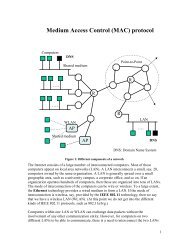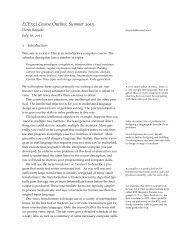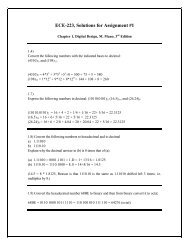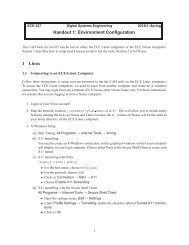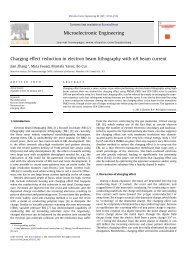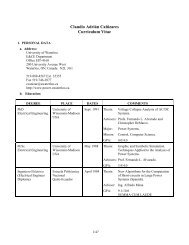ECE 316 – Probability Theory and Random Processes
ECE 316 – Probability Theory and Random Processes
ECE 316 – Probability Theory and Random Processes
You also want an ePaper? Increase the reach of your titles
YUMPU automatically turns print PDFs into web optimized ePapers that Google loves.
Problems<br />
<strong>ECE</strong> <strong>316</strong> <strong>–</strong> <strong>Probability</strong> <strong>Theory</strong> <strong>and</strong> R<strong>and</strong>om <strong>Processes</strong><br />
Chapter 4 Solutions (Part 2)<br />
Xinxin Fan<br />
20. A gambling book recommends the following “winning strategy” for the game of roulette. It<br />
recommends that a gambler bet $1 on red. If red appears (which has probability 18<br />
38 ), then the<br />
gambler should take her $1 profit <strong>and</strong> quit. If the gambler loses this bet (which has probability<br />
20<br />
38 of occurring), she should make additional $1 bets on red on each of the next two spins of<br />
the roulette wheel <strong>and</strong> then quit. Let X denote the gambler’s winnings when she quits.<br />
(a) Find P {X > 0}.<br />
(b) Are you convinced that the strategy is indeed a “winning” strategy? Explain your answer!<br />
(c) Find E[X].<br />
Solution. (a) The event that X > 0 denotes that the gambler wins the first bet or he loses<br />
the first bet <strong>and</strong> wins the next two bets. Therefore, we get<br />
P {X > 0} = P {win first bet} + P {lose, win, win} = 18 20<br />
+<br />
38 38 ·<br />
� �2 18<br />
≈ 0.5981.<br />
38<br />
(b) The strategy described above is not a “winning” strategy because if the gambler wins<br />
then he or she wins $1. However, a loss would either be $1 or $3.<br />
(c) We first note that the r<strong>and</strong>om variable X can take on 1, −1 <strong>and</strong> −3, where “<strong>–</strong>” denotes<br />
that the gambler loses money. Then we obtain<br />
P {X = 1} = P {win first bet} + P {lose, win, win} = 18 20<br />
+<br />
38 38 ·<br />
� �2 18<br />
,<br />
38<br />
P {X = −1} = P {lose, lose, win} + P {lose, win, lose} = 2 · 18<br />
38 ·<br />
� �2 20<br />
,<br />
38<br />
� �3 20<br />
P {X = −3} = P {lose, lose, lose} = .<br />
38<br />
Therefore, we can compute the expectation as follows:<br />
E[X] = 1 · P {X = 1} + (−1) · P {X = −1} + (−3) · P {X = −3} ≈ −0.108.<br />
25. A typical slot machine has 3 dials, each with 20 symbols (cherries, lemons, plums, oranges,<br />
bells, <strong>and</strong> bars). A typical set of dials is shown in Table 1. According to this table, of the<br />
20 slots on dial 1, 7 are cherries, 3 are oranges, <strong>and</strong> so on. A typical payoff on a 1-unit<br />
1
Table 1: Slot machine dial setup<br />
Dial 1 Dial 2 Dial 3<br />
Cherries 7 7 0<br />
Oranges 3 7 6<br />
Lemons 3 0 4<br />
Plums 4 1 6<br />
Bells 2 2 3<br />
Bars 1 3 1<br />
20 20 20<br />
Table 2: Typical payoff on a 1-unit bet<br />
Dial 1 Dial 2 Dial 3 Payoff<br />
Bar Bar Bar 60<br />
Bell Bell Bell 20<br />
Bell Bell Bar 18<br />
Plum Plum Plum 14<br />
Orange Orange Orange 10<br />
Orange Orange Bar 8<br />
Cherry Cherry Anything 2<br />
Cherry No cherry Anything 0<br />
Anything else -1<br />
bet is shown in Table 2. Compute the player’s expected winnings on a single play of the slot<br />
machine. Assume that each dial acts independently.<br />
Solution. Let X denote the payoff on a 1-unit bet. Then we get<br />
P {X = 60} = P {Bar, Bar, Bar} = 1 3 1 3<br />
· · =<br />
20 20 20 8000 ,<br />
P {X = 20} = P {Bell, Bell, Bell} = 2 2 3 12<br />
· · =<br />
20 20 20 8000 ,<br />
P {X = 18} = P {Bell, Bell, Bar} = 2 2 1 4<br />
· · =<br />
20 20 20 8000 ,<br />
P {X = 14} = P {Plum, Plum, Plum} = 4 1 6 24<br />
· · =<br />
20 20 20 8000 ,<br />
P {X = 10} = P {Orange, Orange, Orange} = 3 7 6 126<br />
· · =<br />
20 20 20 8000 ,<br />
P {X = 8} = P {Orange, Orange, Bar} = 3 7 1 21<br />
· · =<br />
20 20 20 8000 ,<br />
P {X = 2} = P {Cherry, Cherry, Anything} = 7 7 49<br />
· =<br />
20 20 400 ,<br />
2
P {X = 0} = P {Cherry, No cherry, Anything} = 7 13 91<br />
· =<br />
20 20 400 ,<br />
P {X = −1} =<br />
3 + 12 + 4 + 24 + 126 + 21 + 980 + 1820<br />
P {Anything else} = 1 −<br />
8000<br />
= 501<br />
800 .<br />
Therefore, the player’s expected winnings on a single play of the slot machine can be computed<br />
as follows:<br />
E[X] = 60 · P {X = 60} + 20 · P {X = 20} + 18 · P {X = 18} +<br />
= 180 + 240 + 72 + 336 + 1260 + 168 + 1960 − 5010<br />
14 · P {X = 14} + 10 · P {X = 10} + 8 · P {X = 8} +<br />
2 · P {X = 2} + 0 · P {X = 0} + (−1) · P {X = −1}<br />
= −0.09925.<br />
8000<br />
32. To determine whether or not they have a certain disease, 100 people are to have their blood<br />
tested. However, rather than testing each individual separately, it has been decided first to<br />
group the people in groups of 10. The blood samples of the 10 people in each group will be<br />
pooled <strong>and</strong> analyzed together. If the test is negative, one test will suffice for the 10 people;<br />
whereas, if the test is positive each of the 10 people will also be individually tested <strong>and</strong>, in<br />
all, 11 tests will be made on this group. Assume the probability that a person has the disease<br />
is 0.1 for all people, independently of each other, <strong>and</strong> compute the expected number of tests<br />
necessary for each group. (Note that we are assuming that the pooled test will be positive if<br />
at least one person in the pool has the disease.)<br />
Solution. Let T be the number of tests for a group of 10 people. Then we know that T = 1<br />
if the test is negative <strong>and</strong> T = 11 if the test is positive. Therefore, we get<br />
E[T ] = (0.9) 10 + 11[1 − (0.9) 10 ] = 11 − 10 · (0.9) 10 .<br />
33. A newsboy purchases papers at 10 cents <strong>and</strong> sells them at 15 cents. However, he is not allowed<br />
to return unsold papers. If his daily dem<strong>and</strong> is a binomial r<strong>and</strong>om variable with n = 10, p = 1<br />
3 ,<br />
approximately how many papers should he purchase so as to maximize his expected profit?<br />
Solution. Let a be the number of papers the newsboy purchases, X be the daily dem<strong>and</strong>,<br />
<strong>and</strong> Y be the profit the newsboy gets. Then we obtain the relation between r<strong>and</strong>om variables<br />
X <strong>and</strong> Y as follows:<br />
Y =<br />
� 5a X ≥ a<br />
15X − 10a X < a .<br />
Therefore, the expected profit that the newsboy obtains is<br />
E[Y ] = 5a · P (X ≥ a) + (15X − 10a) · P (X < a)<br />
=<br />
10�<br />
i=a<br />
5a ·<br />
� 10<br />
i<br />
� � 1<br />
3<br />
� i � 2<br />
3<br />
� 10−i<br />
�a−1<br />
+ (15i − 10a) ·<br />
i=0<br />
� 10<br />
i<br />
� � 1<br />
3<br />
�i � �10−i 2<br />
3<br />
To find the approximate value for a, we can use Matlab to draw the following figure to show<br />
the relation between E[Y ] <strong>and</strong> a. From Fig. 1, we note that the newsboy should purchase 3<br />
papers so as to maximize his expected profit.<br />
3
38. If E[X] = 1 <strong>and</strong> Var(X) = 5, find<br />
(a) E[(2 + X) 2 ];<br />
(b) Var(4 + 3X).<br />
E[Y]<br />
10<br />
0<br />
−10<br />
−20<br />
−30<br />
−40<br />
−50<br />
0 1 2 3 4 5<br />
a<br />
6 7 8 9 10<br />
Figure 1: The Expected Profit E[Y ]<br />
Solution. (a) E[(2 + X) 2 ] = Var(2 + X) + (E[2 + X]) 2 = Var(X) + 9 = 14.<br />
(b) Var(4 + 3X) = 9 · Var(X) = 45.<br />
44. A satellite system consists of n components <strong>and</strong> functions on any given day if at least k of<br />
the n components function on that day. On a rainy day each of the components independently<br />
functions with probability p1, whereas on a dry day they each independently function with<br />
probability p2. If the probability of rain tomorrow is α, what is the probability that the satellite<br />
system will function?<br />
Solution. The probability that the satellite system will function can be computed as follows:<br />
P (system functions) = P (rain)P (system functions | rain) + P (dry)P (system functions | dry)<br />
n�<br />
� �<br />
n<br />
= α · p<br />
i<br />
i 1(1 − p1) n−i n�<br />
� �<br />
n<br />
+ (1 − α) · p<br />
i<br />
i 2(1 − p2) n−i .<br />
i=k<br />
48. It is known that diskettes produced by a certain company will be defective with probability 0.01,<br />
independently of each other. The company sells the diskettes in packages of size 10 <strong>and</strong> offers<br />
a money-back guarantee that at most 1 of the 10 diskettes in the package will be defective. If<br />
someone buys 3 packages, what is the probability that he or she will return exactly 1 of them?<br />
Solution. Let p be the probability that a package will be returned. The we obtain<br />
p = 1 − (0.99) 10 − 10 · (0.99) 9 (0.01).<br />
Therefore, if someone buys 3 packages then the probability they will return exactly 1 package<br />
is 3p(1 − p) 2 .<br />
49. When coin 1 is flipped, it l<strong>and</strong>s heads with probability 0.4; when coin 2 is flipped, it l<strong>and</strong>s<br />
heads with probability 0.7. One of these coins is r<strong>and</strong>omly chosen <strong>and</strong> flipped 10 times.<br />
4<br />
i=k
(a) What is the probability that exactly 7 of the 10 flips l<strong>and</strong> on heads?<br />
(b) Given that the first of these ten flips l<strong>and</strong>s heads, what is the conditional probability that<br />
exactly 7 of the 10 flips l<strong>and</strong> on heads?.<br />
Solution. (a) Note that one of two coins will be r<strong>and</strong>omly chosen, we get<br />
P (7 heads) = P (coin 1)P (7 heads | coin 1) + P (coin 2)P (7 heads | coin 2)<br />
= 1<br />
2 ·<br />
� 10<br />
7<br />
�<br />
· (0.4) 7 · (0.6) 3 + 1<br />
2 ·<br />
� 10<br />
7<br />
(b) We can compute the conditional probability as follows:<br />
P (7 heads | 1st heads) =<br />
Theoretical Exercises<br />
=<br />
�<br />
· (0.7) 7 · (0.3) 3 .<br />
�2 i=1 P (coin i)P (7 heads, 1st heads | coin i)<br />
P (1st heads)<br />
1<br />
2 · � � 9<br />
6 · (0.4) 7 · (0.6) 3 1 + 2 · � � 9<br />
6 · (0.7) 7 · (0.3) 3<br />
1<br />
2<br />
· 0.4 + 1<br />
2<br />
· 0.7<br />
4. If X has distribution function F , what is the distribution function of e X .<br />
Solution. Let G(x) be the distribution function of e X . Then we need to consider the<br />
following two cases:<br />
• When x ≤ 0, we get<br />
• When x > 0, we obtain<br />
G(x) = P {e X ≤ x} = 0.<br />
G(x) = P {e X ≤ x} = P {X ≤ ln x} = F (ln x).<br />
5. If X has distribution function F , what is the distribution function of the r<strong>and</strong>om variable<br />
αX + β, where α <strong>and</strong> β are constants, α �= 0?<br />
Solution. Let G(x) be the distribution function of e X . Then we need to consider the<br />
following two cases:<br />
• When α > 0, we get<br />
• When α < 0, we obtain<br />
G(x) = P {αX + β ≤ x} = P<br />
G(x) = P {αX + β ≤ x} = P<br />
�<br />
X ≥<br />
5<br />
�<br />
X ≤<br />
�<br />
x − β<br />
α<br />
�<br />
x − β<br />
= F<br />
α<br />
� x − β<br />
α<br />
�<br />
.<br />
� �<br />
x − β<br />
= 1 − lim F − h .<br />
h→0 + α<br />
.
8. Let X be such that<br />
Find c �= 1 such that E[c X ] = 1.<br />
P {X = 1} = p = 1 − P {X = −1}.<br />
Solution. We have known the probability mass function of X: P {X = 1} = p <strong>and</strong> P {X =<br />
−1} = 1 − p. Thus,<br />
E[c X ] = c 1 · +c −1 · (1 − p).<br />
Let E[c X ] = cp + 1−p<br />
c<br />
that E[c X ] = 1.<br />
= 1, it follows that c = p<br />
1−p<br />
or 1. Therefore, except 1, c = p<br />
1−p satisfies<br />
9. Let X be a r<strong>and</strong>om variable having expected value µ <strong>and</strong> variance σ 2 . Find the expected value<br />
<strong>and</strong> variance of Y = X−µ<br />
σ .<br />
Solution. Using the properties of expected value <strong>and</strong> variance, we get<br />
E[Y ] =<br />
� �<br />
X − µ<br />
E =<br />
σ<br />
1<br />
Var(Y ) =<br />
1<br />
· E[X − µ] = · (E[X] − µ) = 0,<br />
σ σ<br />
� � � �2 X − µ 1<br />
Var = · Var(X) =<br />
σ σ<br />
σ2<br />
= 1.<br />
σ2 13. Let X be a binomial r<strong>and</strong>om variable with parameters (n, p). What value of p maximizes<br />
P {X = k}, k = 0, 1, . . . , n? This is an example of a statistical method used to estimate p<br />
when a binomial (n, p) r<strong>and</strong>om variable is observed to equal k. If we assume that n is known,<br />
then we estimate p by choosing that value of p that maximizes P {X = k}. This is known as<br />
the the method of maximum likelihood estimation.<br />
Solution. Note that when P {X = k} achieves the maximum value, log P {X = k} also gets<br />
the maximum value. Therefore, we can first take logarithm <strong>and</strong> then determine the p that<br />
maximizes log P {X = k}. More specifically, we first obtain<br />
� �<br />
n<br />
log P {X = k} = log + k · log p + (n − k) · log(1 − p).<br />
k<br />
Then we can find p by computing the derivative as follows:<br />
Therefore, p = k<br />
n<br />
∂<br />
k n − k<br />
log P {X = k} = −<br />
∂p p 1 − p<br />
maximizes P {X = k} for k = 0, 1, . . . , n.<br />
6<br />
= 0.



